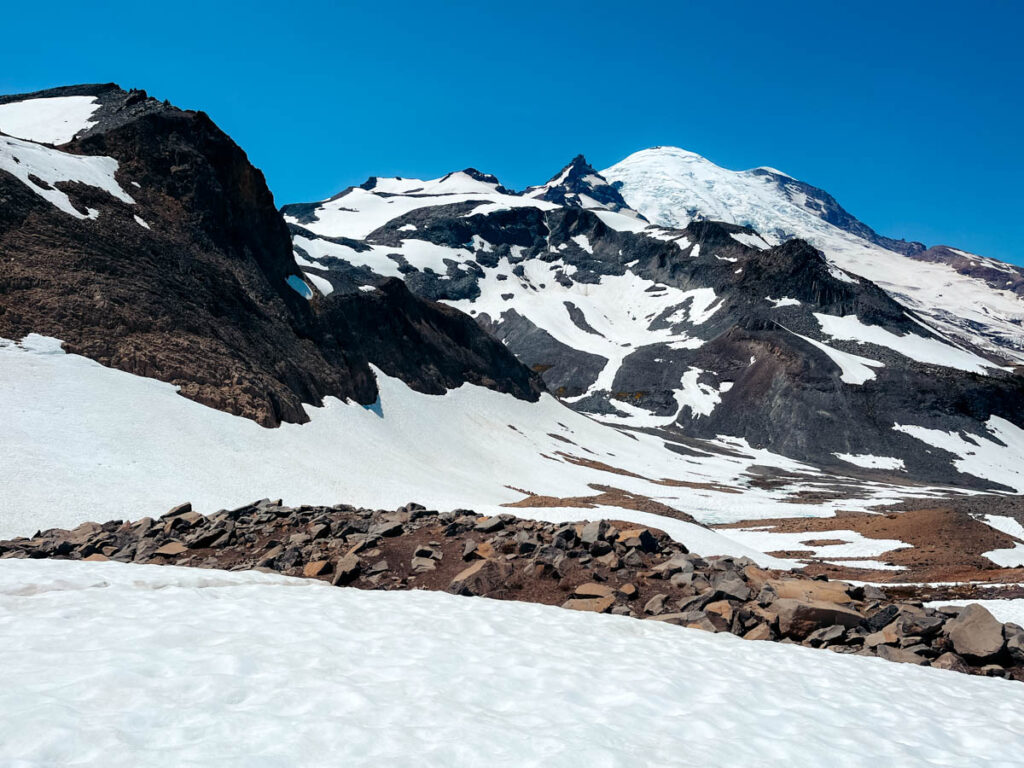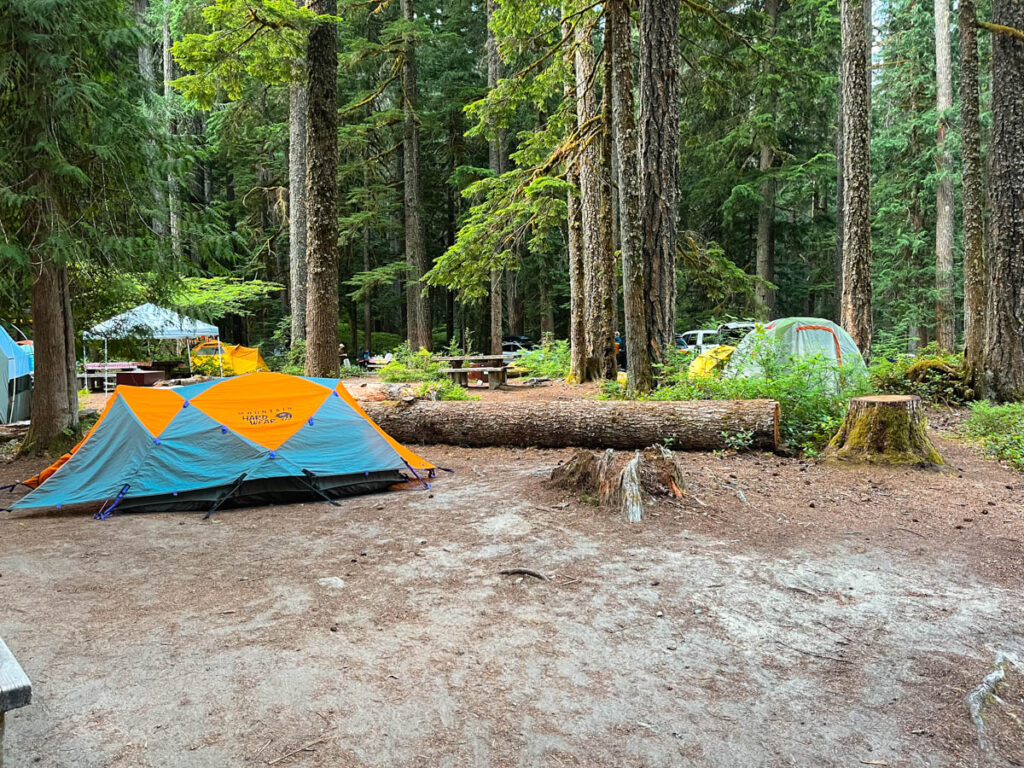
Complete Guide to Mount Rainier National Park
Looming over the Pacific Northwest of the United States, Mount Rainier is a stunning, snow covered mountain. While climbing to the summit of Mount Rainier is highly technical, the area around the mountain offers incredible hiking trails.
This guide to Mount Rainier National Park offers general information to help you plan you visit as well as additional links to explore. We’ve visited Mount Rainier several times and include everything we’ve learned about this National Park.
You can find more National Park Planning Guides on our National Park page and follow along as we visit them all.
As an affiliate partner, purchases through links on this page may result in compensation.
Highlights of Visiting Mount Rainier National Park
- The showstopper of this National Park is Mount Rainier, standing at 14,411 feet tall (4,392 meters). Mount Rainier is an active stratovolcano mountain’s presence can be enjoyed from many viewpoints throughout the park.
- Paradise: This popular area on the southern side of the mountain is known for its alpine meadows, wildflower displays in the summer, and incredible views of Mount Rainier. It’s a great place for hiking and photography.
- Sunrise: Located on the northeastern side of the park, Sunrise offers stunning vistas of the mountain, high alpine meadows, and opportunities for scenic hikes.
- Wonderland Trail: This 93-mile (150 km) trail encircles Mount Rainier and takes hikers through diverse landscapes, including forests, glaciers, and meadows, providing an unforgettable backcountry experience.
- Grove of the Patriarchs is an easy hike near the Stevens Canyon Entrance that leads to a suspension bridge over the Ohanapecosh River and through a lush grove of ancient, towering trees.
- Christine Falls: A beautiful two-tiered waterfall located near the Longmire area, easily accessible from the road.
- Mount Rainier Wildflowers: During the summer months, the park’s meadows burst into a kaleidoscope of colors as wildflowers bloom, creating a vibrant and mesmerizing landscape.
- Wildlife Watching: Mount Rainier National Park is home to a variety of wildlife, including marmots, deer, elk, and occasionally bears, providing opportunities for wildlife enthusiasts and photographers.

Essential Guides
How to Hike the Summerland Trail Mt Rainier to Panhandle Gap
Things to Know About Visiting Mount Rainier National Park
General Overview
Mount Rainier National Park includes the main volcano and the area around this massive mountain. The only way to get from one side to the other of the park is to drive around the mountain. This means that it is easiest to choose a part of the park to visit and then drive from there.
To get from the southeastern part of the park to the northwestern part of the park takes over 2 hours, so most people choose a side of the park to explore. If you are visiting on a day trip, the northwest part of the park offers many hikes (our favorite is the Carbon Glacier Trail).
If you have more time, we recommend spending the time in the southeast part of the park as you can get to several different areas with shorter driving times. On our most recent visit, we camped at the Ohanapecosh Campground and spent time in Paradise, Ohanapecosh, Sunrise.
Below is a general overview of the different parts of Mount Rainier National Park:
- Longmire: Longmire serves as the park’s main entrance and offers historic buildings, a museum, and access to hiking trails in the southwest part of Mount Rainier National Park.
- Paradise: Paradise is a renowned alpine destination with vibrant wildflower meadows, stunning views of Mount Rainier, and various hiking opportunities in the southern part of the park.
- Ohanapecosh: Located in the southeast, Ohanapecosh features a beautiful rainforest with hot springs, ancient trees, and scenic river views.
- Sunrise: Sunrise is situated on the northeast side of the mountain, providing visitors with high alpine meadows, breathtaking vistas, and access to the Wonderland Trail.
- Carbon River & Mowich: These remote areas on the northwest side offer a lush rainforest, the Carbon River’s tranquil beauty, and the picturesque Mowich Lake, providing a quieter and more secluded experience.

Best Time to Visit Mount Rainier National Park
The best time to visit Mount Rainier is during the summer months. Many of the road are closed during the winter due to snowfall and don’t reopen until later spring. Early summer is lovely when the wildflowers are in bloom.
Summer is also the most popular time to visit the park and you will find many people and full parking lots. Since the season is short, we recommend getting an early start in the morning to maximize your chance of finding parking.
The table below shows the average weather during the year at Ohanapecosh.

How to Get to Mount Rainier NP
Mount Rainier is just a couple hours from both Seattle, WA and Portland Oregon. The best way to get to the park is to fly to Seattle Tacoma airport and rent a car. There is no good public transportation option to get to the different location within the park.

How Much Time do you Need in Mount Rainier
Mount Rainier is a large park with several entrances. If you plan to do multiple hikes in the different areas, you should plan to spent 4-5 days exploring Mount Rainier National Park. If you don’t have this much time, you could also plan to spend two days in the southeastern part of the park and visit Sunrise, Paradise and Ohanepecosh.
Where to Stay
On our most recent visit, we camped at Ohanepecosh Campground. This campground fills up quickly and registration opens 6 month prior to your visit. You can learn more on Recreation.gov.
There are also several lodges and hotels nearby. If you are looking for something comfortable on the south side of the park, check out: Parkwood Lodge and Cabins.

Need to Know: Guide to Mount Rainier National Park
Below you can some important things to know about visiting Mount Rainier National Park.
- Diverse Ecosystems: The park boasts diverse ecosystems, including glaciers, subalpine meadows, old-growth forests, and even a temperate rainforest.
- Weather Variability: Weather conditions at Mount Rainier can change rapidly and dramatically. Visitors should be prepared for sudden temperature drops, rain, and even snow at higher elevations, regardless of the season. Note the elevation when you are hiking as this has a big impact on the weather.
- Wildlife: The park is home to various wildlife, including deer, elk, marmots, mountain goats, and black bears. Visitors should maintain a safe distance and never feed the animals.
- Wildflower Blooms: In the summer, the park’s meadows burst into a colorful display of wildflowers, attracting numerous visitors and photographers.
- Hiking Opportunities: Mount Rainier National Park offers over 260 miles (418 km) of hiking trails, catering to different skill levels and providing access to some of the most breathtaking scenery in the region.
- Climbing Mount Rainier: Climbing the mountain requires technical skills and preparation due to its glacier-covered slopes and unpredictable weather conditions. Many climbers attempt the climb each year, but it is not recommended for beginners.
- Road Access: The park has several entrances, with the Nisqually Entrance and the Stevens Canyon Entrance providing access to popular destinations like Paradise and Sunrise, respectively.
- Wilderness Permits: Backcountry camping and certain areas of the park require wilderness permits, which can be obtained at the park’s visitor centers. These permits help manage the impact on the environment and ensure a safe experience for visitors.
Please practice LEAVE NO TRACE. This means staying on trails, following posted signs and packing out everything you pack in.

Looking for more adventures?
Check out Olympic National Park or consider combining Mount Rainier NP and Olympic National Park into a week long itinerary.
You might also enjoy our Ultimate Guide to Planning a National Park trip in the United States.


